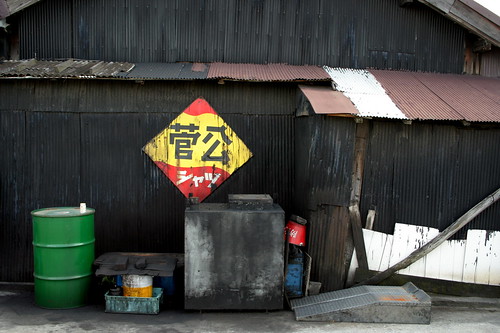Osaka Pref., Fujiidera city
大阪府藤井寺市
I’ve seen and posted many photos of similar apartment buildings but have yet to explain them. this simple two story apartment block was very popular in the post war years. Yuko told me that prior to the Great Hanshin Earthquake these were quite common in her neighborhood but were replaced after the earthquake. In general the entire area has gone through a great deal of gentrification in the last 10 years.
Wednesday, October 31, 2007
Japanese Landscape: Old Style Apartment Block
PLEASE FOR HEALTHY LIFE
Engrish Eggs!
Osaka Pref., Fujiidera city
大阪府藤井寺市
FRESH
EGGS
IT’S... COUNTRY
BRED.
PLEASE FOR HEALTHY LIFE
Monday, October 29, 2007
Okadera and Nara Park
While the rest of the gaijin community is getting flustered over this, I’d rather go to cool temples. Yuko’s Mom has been on a route going to various temples around Kansai and getting a scroll signed and stamped at each one. This is much like the famous 88 temple route in Shikoku. Sadly I’m not that well versed on Buddhism and I cannot explain the meaning behind it all, but I can say that the temples are beautiful. Okadera (lit. hill temple) was especially beautiful.

A view of main temple of Okadera from the walking path that circles the temple grounds.

A moss and fungus covered tree stump on the grounds of Okadera

A lady selling drinks and snacks near the public restrooms in Nara Park

A priest signing the temple's name in Nara Park.
The rest of the photos from this trip can be found in this set.
Firestorm
I look back upon it as an incredible experience. Maybe one that has made me stronger in the face of other disasters and made me less connected to things in a way that makes living abroad easier.
These are the few photos from the event that I have on my computer.
Sunday, October 21, 2007
Two views of rural detritus in Nara prefecture.
1. The Pachinko Parlor
The popular past-time of grandpas has fallen on hard times. Due to changes in gaming laws and pressure from the government pachinko parlors have turned away from big reward-big loss scenarios in favor for low risk-low reward gaming. This has turned away the hardened gamblers. While it still remans profitable, it can no longer pull in as many customers. Those parlors in older centrally located shotengai (shopping streets) like this one have closed down as more people head to larger shopping centers and pachinko parlors on the outskirts of town.
2. The related businesses
This cafe next to the pachinko parlor also went the same way as it's neighbor. One can imagine that it sustained on serving those going to or leaving the neighboring pachinko parlor. Whether or not it is related to the pachinko parlor’s closure is unknown; nevertheless the two events are tied to the general aging of city centers. The urban renewal movement that is rebuilding many of America's downtowns has yet to come to Japan--at least in the same way. I don't know if shotengai (shopping streets), sento and the like are under the threats that their counterparts in America have faced either. Crime being the most important of those threats. Also, suburban development and subsequent shopping centers are servicing a new and expanding lifestyle choice for many Japanese--especially young families.
Old and deterioating shotengai, such as this one I found in Nara prefecture, have an atmosphere and style that is worth paying attention to.
Wednesday, October 10, 2007
Be The Best Bacon For The Fans?
The Hanshin Tigers have their own bacon now. It's not too bad either! I bet you'll not find this for sale up in Tokyo.
Sunday, October 07, 2007
Japanese Landscape: Night in the City
Osaka's night time sky.
Early morning in the city after the last trains have run has an amazingly tranquil feeling, but that tranquility is like a thin fog over the early morning festivities which hide around every corner, under every tree, behind every sign.
Tuesday, October 02, 2007
Japanese Landscape: Wakayama City
Japanese Vernacular Landscape: Oshibori delivery
Oshibori are damp hand-towels that are given out at restaurants. Commonly one of the things that people miss about Japan when they return home. I love them to. Most cheaper places have plastic wrapped paper oshibori, but many restaurants use cotton ones. These are delivered typically in the morning before most restaurants open for lunch where they are put into heaters or coolers, depending on the season, for customers. Companies like KCC deliver the fresh wrapped oshibori for the previous days used ones for washing and reuse.
This photo was taken in around 10:00 AM in Umeda.















